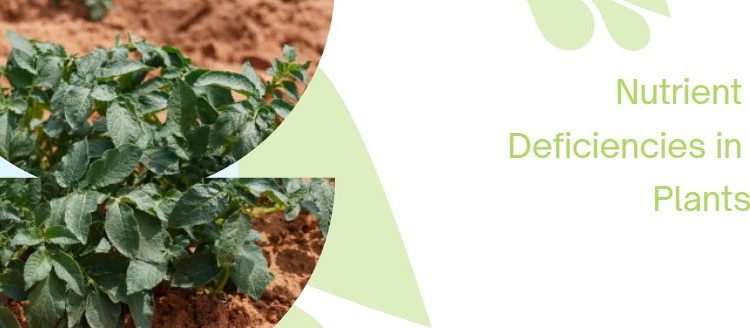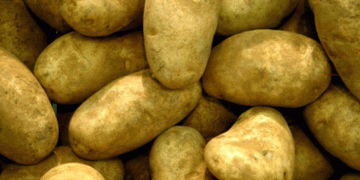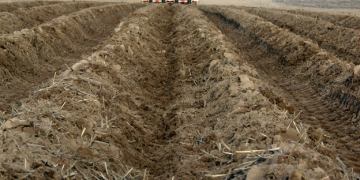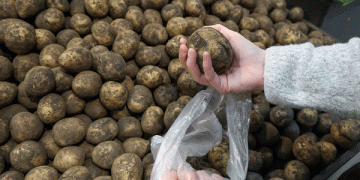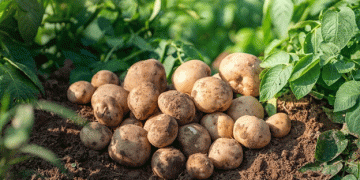#Agriculture #NutrientManagement #PlantHealth #CropMonitoring #AnalyticalTesting
Plants require essential nutrients for their growth and development. Detecting nutrient deficiencies is crucial for maintaining healthy crops and maximizing yield. Visual observation is a common method to identify nutrient stresses, but various other factors can cause similar physiological disorders. Therefore, analytical testing is recommended to confirm nutrient-related issues accurately.
Development of Nutrient Deficiencies
Visual symptoms of nutrient deficiencies manifest in plants when they lack vital nutrients. These symptoms can be misleading as they might also be caused by different stressors like cold soil temperatures, soil moisture stress, root damage, or disease infections. Hence, it is essential to perform analytical testing to ensure accurate diagnosis.
Consequences of Nutrient Deficiencies
Once visual symptoms appear, it’s likely that a yield penalty has already occurred. Although nutrient applications can prevent further decline, they cannot recover any lost yield. Timely detection and corrective measures are vital for mitigating yield losses due to nutrient imbalances or deficiencies.
Petiole Nutrient Analysis
Petiole nutrient analysis is a widely used diagnostic method to track nutrient accumulation in growing crops. It serves as an indicator of nutrient availability to the plant, rather than just measuring total nutrient concentration in the soil. Petioles are ideal for monitoring nitrate-nitrogen, phosphorus, and potassium and are easy to collect, wash, and handle while representing the entire plant.
In-Crop Monitoring Considerations
To effectively manage nutrient deficiencies, farmers and agronomists should consider the following in-crop monitoring guidelines:
Early Monitoring: Initiate in-crop soil and petiole monitoring early in the growing season (Growth Stage 2) to allow sufficient time for seeking advice and implementing necessary changes.
Adaptability: Be open to adjusting the fertilization plan, even with minor changes, based on monitoring results and expert recommendations.
Control Strip: Implement a control strip when modifying the nutrient management strategy and objectively measure differences between treated and untreated areas.
Tailored Strategies: Different zones and cultivars may require distinct fertilization programs, so be prepared to adapt strategies accordingly.
Identify Savings: Soil tests can identify potential savings, not just costs. Not all expenses are negative if they lead to better nutrient management.
Petiole Sample Analysis
Petiole samples should be submitted to an accredited plant testing laboratory. Analysis is usually conducted on either dried and ground whole tissue samples or sap extracted from the petiole. Nutrient concentration results are categorized as deficient, low (marginal), adequate (satisfactory), high, or excess (toxic).
It is crucial to note that critical thresholds for tissue and sap samples are not interchangeable. Always confirm that the same testing methodology has been used before comparing results across different crops or seasons. Also, providing cultivar and growth stage information on the petiole sample submission form ensures accurate reporting of threshold values.
Comprehensive Assessment
Interpreting petiole nutrient test results requires considering other information, such as in-crop soil testing (especially for nitrogen availability), crop knowledge, and past experience. A holistic approach to nutrient management is essential for maintaining healthy plants and maximizing agricultural productivity.
Table 3-2:Common symptoms and occurrence of nutrient deficiency in potato (adapted from Hopkins et al2020, Mikkelsen
and Hopkins 2009, and Maier and Shepherd 1998)
| Nutrient | Deficiency symptoms | Disorders showing similar symptoms |
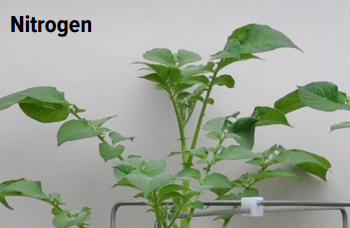 | Plants display a light green colour and may have stunted growth. Older leaves turn light yellow (chlorosis) and may die (senesce). It is too late to correct an N deficiency once visual symptoms are observed. | – Sulfur or Molybdenum deficiency. – Insufficient soil moisture. – Cold weather. – Root damage from nematodes or other pests. |
 | Plants are small, spindly and somewhat rigid that may display purpling blush on lower leaves. Leaflets can be a dull dark green with margins that roll upward, becoming more pronounced with severe deficiency. Lateral root development may be inhibited and single small flecks may develop in the tubers. | • Cold soil temperature. • Soil moisture stress. • Root damage from pathogens or pests. • Late blight infection. |
 | Stunted by mid-season with yellowing and scorching on the old leaves as potassium translocates from older vegetation to younger growth. Younger leaves may be small and glossy with pronounced crinkling on the margins. Tubers are reduced in number and size with an increased risk of developing black spot. | • Magnesium deficiency. • High salinity. • Wind burn. • Water stress. |
 | Symptoms develop slowly and are similar to those of nitrogen, except the yellowing appears first in the younger leaves that turn uniformly light green to yellow and may show some upward rolling | Nitrogen deficiency. |
 | Younger leaves are lacklustre, initially exhibiting interveinal chlorosis and a slight upward cupping with small grey and black spotting that increase in size and number over time. Spot density gradually increases along the larger leaf veins, eventually producing necrotic patches and severely reducing yields. | Iron, zinc or copper deficiency. |
 | The youngest leaves become narrow, erect, chlorotic, and develop tip burn and leaf cupping. Zinc deficiency is often referred to as “fern leaf”. Blotching and grey brown irregular spots develop on the interveinal tissues with severe deficiency and the lower leaves turn brown and die | • Iron, manganese, or copper deficiency. • Waterlogging induced iron and manganese deficiency. |
 | Plants are stunted and rigid. Young leaves remain green and are of normal size but exhibit a pronounced rolling and cupping. Leaf tips eventually wilt and die while the underside of lower leaves may have a purple colouration. | Sulfur, manganese and iron deficiency. |
 | Young leaves become yellow to nearly white in extreme cases, usually without necrosis. Leaf veins appear greener than the interveinal tissue. Leaf tips and edges remain green the longest. | Sulfur, manganese and zinc deficiency. |
 | Plants appear bushy with shortened internodes. Leaf blades thicken and roll upward and develop light brown edges. Points and margins of the lower leaves die prematurely and eventually the growing buds die, and leaf tissue darkens and collapses. Boron deficiency has a negative impact on root growth. | • Calcium deficiency. • Leaf roll virus. • Damage from insects, hail or pesticide sprays. |
 | Deficient plants are spindly with small, upward rolling, and wrinkled leaflets. The youngest leaves near the growing point exhibit marginal chlorosis and brown spotting. Growing buds may die and tubers develop dead spots in the pith region. | Boron deficiency. |
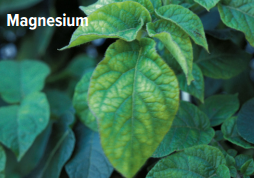 | Initially, a slight interveinal chlorosis develops on young, fully expanded leaves with some brown spotting and brittleness that terminates as interveinal leaf scorch. Symptoms become most severe in the oldest leaves, while leaves near the growing point remain green | • Virus infection. • Virus induced leaf roll. • Potassium deficiency or salt burn. |
| Molybdenum | Leaf blades become uniformly yellow similar to nitrogen and Nil sulfur deficiencies. | |
| Chloride | Young leaves are initially light green and then turn a purplish Nil bronze. Leaves curl upward and/or appear pebbled. When severe, tips of young leaves pinch together and pucker up to form a cup shape. |
Quick Key[1] Symptoms of plant nutrient stress
[table id=6 /]
Source: Australian Potato Growers
